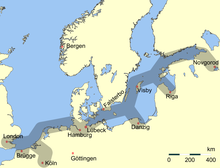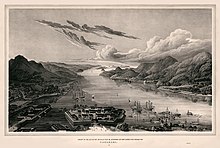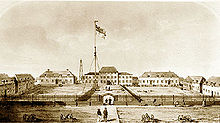Factory (trading post)
This article needs additional citations for verification. (August 2016) |

Factory was the common name during the
: factorerie, comptoir).The factories established by European states in Africa, Asia and the Americas from the 15th century onward also tended to be official political dependencies of those states. These have been seen, in retrospect, as the precursors of colonial expansion.
A factory could serve simultaneously as
In North America, Europeans began to trade with Natives during the 16th century. Colonists created factories, also known as trading posts, at which furs could be traded, in Native American territory.
European medieval factories


Although European
Originally, factories were organizations of European merchants from a state, meeting in a foreign place. These organizations sought to defend their common interests, mainly economic (as well as organized insurance and protection), enabling the maintenance of diplomatic and trade relations within the foreign state where they were set.
The factories were established from 1356 onwards in the main trading centers, usually ports or central hubs that have prospered under the influence of the
actively tried to take over the monopoly of trade from the Hansa, inviting foreign merchants to join in.Because foreigners were not allowed to buy land in these cities, merchants joined around factories, like the Portuguese in their Bruges factory: the factor(s) and his officers rented the housing and warehouses, arbitrated trade, and even managed insurance funds, working both as an association and an embassy, even administering justice within the merchant community.[2]
Portuguese feitorias (c. 1445)
During the territorial and economic expansion of the
and were governed by a feitor ("factor") responsible for managing the trade, buying and trading products on behalf of the king and collecting taxes (usually 20%).
The first Portuguese feitoria overseas was established by
Between the 15th and 16th centuries, a chain of about 50
From the feitorias, the products went to the main outpost in Goa, then to Portugal where they were traded in the Casa da Índia, which also managed exports to India.[5] There they were sold, or re-exported to the Royal Portuguese Factory in Antwerp, where they were distributed to the rest of Europe.
Easily supplied and defended by sea, the factories worked as independent colonial bases. They provided safety, both for the Portuguese, and at times for the territories in which they were built, protecting against constant rivalries and piracy. They allowed Portugal to dominate trade in the Atlantic and Indian oceans,
Dutch factorij and other European factories (1600s)


Other European powers began to establish factories in the 17th century along the trade routes explored by Portugal and Spain, first the Dutch and then the English. They went on to establish in conquered Portuguese feitorias and further enclaves, as they explored the coasts of Africa, Arabia, India, and South East Asia in search of the source of the lucrative spice trade.
Factories were then established by chartered companies such as the Dutch East India Company (VOC), founded in 1602, and the Dutch West India Company (WIC), founded in 1621. These factories provided for the exchange of products among European companies, local populations, and the colonies that often started as a factory with warehouses. Usually these factories had larger warehouses to fit the products resulting from the increasing agricultural development of colonies, which were boosted in the New World by the Atlantic slave trade.
In these factories, the products were checked, weighed, and packaged to prepare for the long sea voyage. In particular, spices, cocoa, tea, tobacco, coffee, sugar, porcelain, and fur were well protected against the salty sea air and against deterioration. The factor was present as the representative of the trading partners in all matters, reporting to the headquarters and being responsible for the products’ logistics (proper storage and shipping). Information took a long time to reach the company headquarters, and this was dependent on an absolute trust.
Some Dutch factories were located in
North American factories (1697 to 1822)
The American factories often played a strategic role as well, sometimes operating as forts, providing a degree of protection for colonists and their allies from hostile Indians and foreign colonists.

York Factory was founded by the chartered Hudson's Bay Company in 1697. It was headquarters of the company for a long time, and was once the de facto government in parts of North America such as Rupert's Land, before European-based colonies existed. It controlled the fur trade throughout much of British-controlled North America for several centuries, undertaking early exploration. Its traders and trappers forged early relationships with many groups of American Indians, and a network of trading posts formed the nucleus for later official authority in many areas of Western Canada and the United States.
The early coastal factory model contrasted with the system of the French, who established an extensive system of inland posts and sent traders to live among the tribes of the region. When war broke out in the 1680s between France and England, the two nations regularly sent expeditions to raid and capture each other's fur trading posts. In March 1686, the French sent a raiding party under Chevalier des Troyes over 1,300 km (810 mi) to capture the company's posts along James Bay. In 1697,
The United States government sanctioned a factory system from 1796 to 1822, with factories scattered through the mostly territorial portion of the country.
The factories were officially intended to protect
A blacksmith was usually assigned to the factory to repair utensils and build or maintain plows. The factories frequently also had some sort of milling operation associated with them.
The factories marked the United States' attempt to continue a process originally pioneered by the
Factories were frequently called "
Examples
In Canada, the Hudson's Bay Company created several factories,[6] including:
- Rupert House, 1668 (now Waskaganish, Quebec)
- Moose Fort, 1673 (now Moose Factory, Ontario)
- Fort Albany, 1679 (Ontario)
- York Factory, 1684 (Manitoba)
- Fort Severn, 1685 (Ontario)
- Churchill River Post, 1717 (now Churchill, Manitoba)
In the United States factories under the Superintendent of Indian Trade:[7]
- Creek:
- Colerain, 1795–1797
- Fort Wilkinson, 1797–1806
- Ocmulgee Old Fields, 1806–1809
- Fort Hawkins, 1809–1816
- Fort Mitchell, 1816–1820
- Cherokee:
- Fort Tellico, 1795–1807
- Fort Hiwassee, 1807–1810
- Fort Wayne, 1802–1812
- Choctaw:
- Fort St. Stephens, 1802–1815
- Fort Confederation, 1816–1822
- Fort Chickasaw Bluffs, 1802–1818
- Fort Detroit, 1802–1805
- Fort Arkansas, 1805–1810
- Fort Chicago, 1805–1822
- Fort Belle Fontaine, 1805–1809
- Natchitoches—Sulphur Fork
- Fort Natchitoches, 1805–1818
- Fort Sulphur Fork, 1818–1822
- Fort Sandusky, 1806–1812
- Fort Madison, Iowa 1808–1815
- Fort Osage, 1808–1822
- Fort Mackinac (Michilimackinac), 1808–1812
- Fort Green Bay, 1815–1822
- Fort Praire du Chien, 1815–1822
- Fort Edwards, 1818–1822
- Fort Spadre Bluffs (Illinois Bayou), 1818–1822
References
- ^ Webster's Encyclopedic Unabridged Dictionary of the English Language, Portland House, New York, 1983.
- ISBN 972-8325-47-9
- ^ Diffie 1977, pp. 314–315
- ^ Diffie 1977, pp. 320–322
- ^ Diffie 1977, p. 316
- ^ Voorhis, Ernest (1930). "Historic Forts of the French Regime and of the English Trading Companies". enhaut.ca/voor1. Government of Canada. Retrieved 24 April 2016.
- ^ "Preliminary Inventory (PI 163) of the Records of the Bureau of Indian Affairs (RG 75), Washington, D.C. Area". 1965. Retrieved 19 June 2023.
Sources
- Braudel, Fernand (1992). Civilization and Capitalism, 15th–18th Century: The perspective of the world. University of California Press. ISBN 0-520-08116-1.
- Boxer, Charles Ralph (1969). The Portuguese Seaborne Empire 1415–1825. Hutchinson. ISBN 0-09-131071-7.
- ISBN 0-521-57464-1.
- Rau, Virginia (1965). "Feitores e feitorias – 'Instrumentos' do comércio internacional português no Séc. XVI". Brotéria. 81 (nº 5).
- Diffie, Bailey (1977). Foundations of the Portuguese Empire, 1415–1580. University of Minnesota Press. ISBN 0-8166-0782-6.
External links
- Wisconsinhistory.org definition Archived 2017-03-17 at the Wayback Machine
- Chicago History
